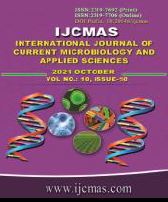


 National Academy of Agricultural Sciences (NAAS)
National Academy of Agricultural Sciences (NAAS)

|
PRINT ISSN : 2319-7692
Online ISSN : 2319-7706 Issues : 12 per year Publisher : Excellent Publishers Email : editorijcmas@gmail.com / submit@ijcmas.com Editor-in-chief: Dr.M.Prakash Index Copernicus ICV 2018: 95.39 NAAS RATING 2020: 5.38 |
Methicillin resistant Staphylococcus aureus (MRSA) is major cause of nosocomial and community infections. Its prevalence varies with country and with hospitals within a country. Therefore, it is important for continuous surveillance in hospitals and other healthcare facilities in order to limit the spread of infections caused by MRSA. To determine the antibiogram of Staphylococcus aureus in a tertiary care hospital and to determine the change in trends in the antimicrobial susceptibility pattern of Staphylococcus aureus. To determine the prevalence of MRSA in a tertiary care hospital. This cross- sectional study was conducted at the Department of Microbiology, SMSR, Sharda University and Hospital. A total of 100 strains identified by morphological and biochemical characteristics were tested for antibiotic susceptibility using Kirby-Bauer disc diffusion method and the Prevalence of Inducible Clindamycin Resistance among the isolates. 100 out of 13,639 isolates clinical comprising samples were obtained Pus (78.6%), Blood (7%), Swab (4.1%), Sputum (4.1%), Urine (4.1%), Semen (2%). Maximum MRSA were obtained from pus samples (81%). However, out of total 7 isolates of Staphylococcus aureus obtained from blood 4 were MRSA and 3 were MSSA. The prevalence of MRSA that is (40%) infections was a high in our setup and is comparable to studies done earlier. This trend is particularly alarming for Staphylococcus aureus because of the severity and diversity of disease caused by this uniquely versatile pathogen.
 |
 |
 |
 |
 |